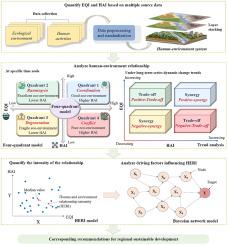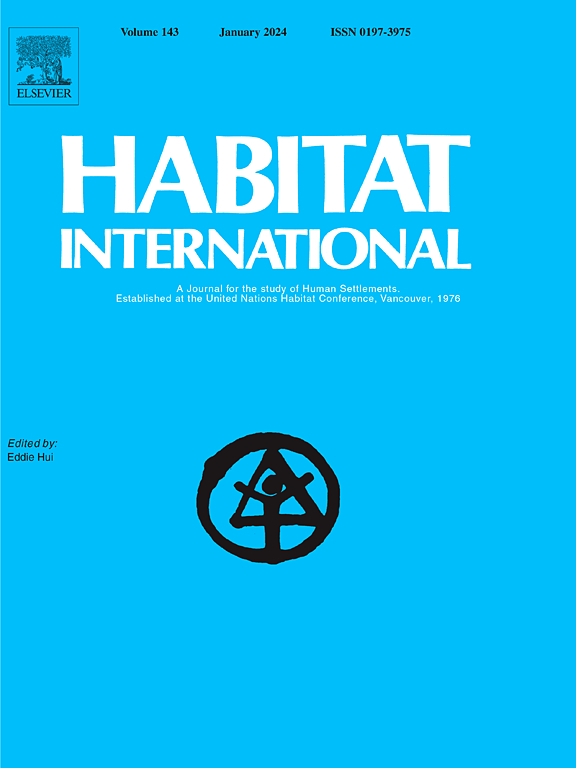Exploring symbiotic pathways: Unveiling the evolution and key drivers of China's human-environment relationship
IF 6.5
1区 经济学
Q1 DEVELOPMENT STUDIES
引用次数: 0
Abstract
Rapid urbanization increased human demand for natural resources, disrupting the balance between human and environment. This disruption led to regional environmental degradation, frequent natural disasters, and severe challenges in achieving sustainable development goals. In this context, fostering human and environment harmony is essential. However, research on quantifying their relationship and exploring the driving factors and mechanisms at a national fine spatial scale remains insufficient. This study endeavours to address this gap by constructing China's eco-environmental quality index (EQI) and human activity intensity (HAI) evaluation index systems with a 1 km resolution. Furthermore, the study utilizes the four-quadrant model and trend analysis to reveal the human-environment relationship, and employs the Bayesian network model to explore key drivers and underlying mechanisms influencing their relationship, aiming to foster harmonious human-environment interaction. Our results show that: (1) Both EQI and HAI increased over time, with their high values concentrated on the southeast side of the Hu Line but low on the northwest side. (2) The proportions of coordination and running-in areas increased while those of degradation and conflict areas declined, with 36.77% of the regions showing positive synergy during 2000–2020, indicating that China's human-environment relationship tended toward coordination. (3) Bayesian network analysis identified land use intensity, GDP, fraction vegetation coverage, and population density as critical factors affecting human-environment relationship. From a quadrant-based analysis, natural and eco-environmental factors including precipitation, water yield, and net primary productivity mainly influenced the spatial distribution of coordination and running-in intensity, while socioeconomic factors like population density and GDP primarily drove the spatial distribution of degradation and conflict intensity. This study finally proposed tailored management recommendations which would provide scientific support to facilitate the coordination and harmony of regional human-environment relationship.

探索共生之路:揭示中国人类与环境关系的演变和关键驱动因素
快速城市化增加了人类对自然资源的需求,破坏了人类与环境之间的平衡。这种破坏导致区域环境退化,自然灾害频发,实现可持续发展目标面临严峻挑战。在这种情况下,促进人类与环境的和谐至关重要。然而,在国家精细空间尺度上量化二者关系并探索其驱动因素和机制的研究仍然不足。本研究通过构建中国 1 公里分辨率的生态环境质量指数(EQI)和人类活动强度(HAI)评价指标体系,努力填补这一空白。此外,本研究还利用四象限模型和趋势分析揭示了人类与环境的关系,并采用贝叶斯网络模型探讨了影响两者关系的关键驱动因素和内在机制,旨在促进人类与环境的和谐互动。我们的研究结果表明(1) 随着时间的推移,EQI 和 HAI 均有所上升,高值集中在沪线的东南侧,而低值则集中在西北侧。(2) 2000-2020 年间,协调区和磨合区的比例上升,退化区和冲突区的比例下降,有 36.77% 的区域呈现正协同,表明中国的人类与环境关系趋于协调。(3) 贝叶斯网络分析发现,土地利用强度、GDP、植被覆盖率和人口密度是影响人类与环境关系的关键因素。从基于象限的分析来看,降水量、产水量和净初级生产力等自然和生态环境因子主要影响协调和磨合强度的空间分布,而人口密度和 GDP 等社会经济因子主要驱动退化和冲突强度的空间分布。本研究最后提出了有针对性的管理建议,为促进区域人类与环境关系的协调与和谐提供了科学支持。
本文章由计算机程序翻译,如有差异,请以英文原文为准。
求助全文
约1分钟内获得全文
求助全文
来源期刊

Habitat International
Multiple-
CiteScore
10.50
自引率
10.30%
发文量
151
审稿时长
38 days
期刊介绍:
Habitat International is dedicated to the study of urban and rural human settlements: their planning, design, production and management. Its main focus is on urbanisation in its broadest sense in the developing world. However, increasingly the interrelationships and linkages between cities and towns in the developing and developed worlds are becoming apparent and solutions to the problems that result are urgently required. The economic, social, technological and political systems of the world are intertwined and changes in one region almost always affect other regions.
 求助内容:
求助内容: 应助结果提醒方式:
应助结果提醒方式:


